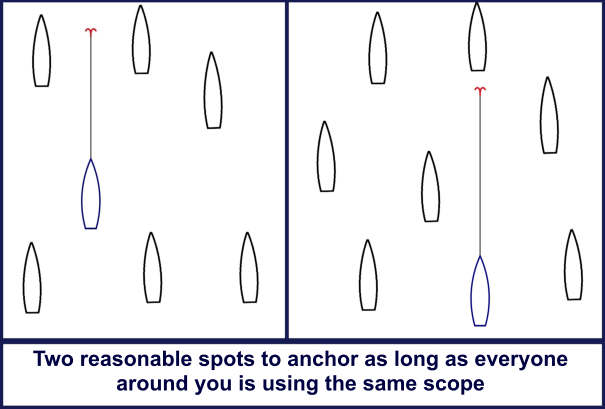The Blue View - Anchoring in a Crowd
/Once we have picked out an anchorage, the next decision is where in the anchorage is the best place to drop the hook. If the anchorage is large with few other boats and no hazards, any number of places may be just fine, but sometimes it takes some thought to find an acceptable spot, especially in a crowded anchorage.
Before we decide where to anchor in a crowd, we first motor slowly through the anchorage to see how the other boats are anchored. Quite often, boats anchored in a crowded anchorage use less scope than usual, and we want to use the same scope as the other vessels around us – within reason. With our all chain rode, we never use a scope of less than 3:1. If we were using a nylon rode, the minimum scope we would use would be 4:1. If we do anchor with a reduced scope, we will set the anchor with a normal scope, and once the anchor has dug in, we reduce the scope as needed. We have no qualms about motoring up to nearby boats and asking them how much rode they have out as we reconnoiter an anchorage. We can also get an idea of how much scope the other vessels have deployed by estimating the distance between boats.
It is also important to use the same anchoring arrangement as the other boats. If everyone is using two anchors, we follow suit – otherwise, our swinging circle will be much different than the other boats.
If the wind or the current is strong enough to stretch out the anchor rodes of the other vessels, finding a spot is somewhat easier. To locate the right place to drop the anchor, we first find the place we want Nine of Cups to lie and check the depth. Then we calculate how much chain we will need to obtain the desired scope, add 20 feet or so to allow some room for the anchor to set, and motor forward that amount. When we reach the right spot, we stop the boat and begin dropping the anchor as we fall back. Ideally, this spot will be right behind or just alongside the vessel in front of us. Then we deploy and set the anchor normally. If I've miscalculated, and we don't end up in the right spot, we don't hesitate to bring the anchor back in and try again.
For example, let's say the spot we want to end up at is in 25 feet (7.5m) of water. The bow roller on Nine of Cups is 5 feet (1.5m) above the water. If we want a scope of 4:1, we will need (25+5)*4 or 120 feet (37m) of chain out. Adding 20 feet (6m) means we need to motor forward about 140 feet (43m), or just over 3 boat lengths for our 45' (14m) boat.
The illustrations below show a couple of crowded anchorages and where we would have chosen to drop the anchor.
If the anchorage is calm and the other boats are lying in all directions in a crowded anchorage, finding the right spot is much more difficult. If possible, we will often anchor further out, with the thought that we will move in closer when the wind picks up. When anchoring further out is not possible, we make our best guess as to the right spot, and stay close to the boat until we are sure we won't be banging into someone. As the most recent arrival, it is our obligation to move if we are too close to another vessel.
Here are some other considerations when selecting a spot to drop the anchor:
Like vessels – Light displacement, heavy displacement, shallow draft and deep keeled vessels all react to wind and current differently while at anchor. If you have a choice, try to anchor near boats similar to yours.
Moored boats – Moored vessels usually have less scope than anchored vessels. If we are anchoring near a moored boat, we give it more space as we will need more swinging room.
Unoccupied areas – If we find a large unoccupied area in an otherwise crowded anchorage, there is usually a good reason. Maybe we lucked out and several boats just left, but more likely there is a shallow spot or hazard there that the local boats know about. If the charts don't show anything, we do a careful and slow exploration of the area before dropping the hook. And again, we're not shy about soliciting information from boats already anchored.
Large expensive yachts – If we have a choice, we will avoid anchoring near a large expensive motor yacht. They are more likely to have and use jet skis and other water toys, fly past us several times a day in their large, high speed tenders, and will probably be running their generator(s) all night. It really spoils the moment when we find ourselves downwind of a diesel generator while trying to enjoy an otherwise perfect sunset.




